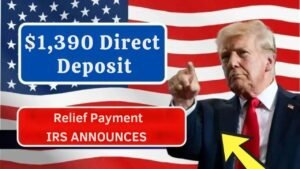Every year, Alaskans look forward to the Permanent Fund Dividend (PFD)—a unique annual payment that shares the state’s oil wealth with its residents. For 2025, the official PFD amount is $1,400, and although many online posts refer to it as a “stimulus check,” it is not a federal program. Instead, it is a long-running state benefit available only to qualifying Alaska residents.
The PFD continues to play an important role across the state, especially in areas where food, fuel, and other essentials cost far more than the national average. Below is a simple, up-to-date breakdown of the 2025 program, who qualifies, when payments are issued, and how the amount is determined.
What the $1,400 PFD Really Is
The Alaska Permanent Fund was created in 1982 to ensure that a portion of the state’s oil revenue benefits current and future residents. Each year, earnings from the fund—including royalties, investments, and market returns—are analyzed to decide how much each eligible resident will receive.
Although the 2025 dividend of $1,400 is lower than some previous record years, it still provides meaningful financial support to families dealing with high living costs. It also continues Alaska’s long-standing tradition of sharing natural resource income with its people.
Eligibility Requirements for the 2025 PFD
To receive the 2025 Alaska Permanent Fund Dividend, applicants must meet strict residency and legal requirements. The core qualifications include:
Residency Rules
- Lived in Alaska for the entire 2024 calendar year
- Intend to remain a permanent Alaska resident
- Physically present in the state, unless absent for approved reasons such as:
- Medical treatment
- Military service
- College or vocational education
- Certain employment opportunities
- No disqualifying criminal convictions or legal restrictions
Application Deadline
- Applications must be submitted between January 1 and March 31, 2025
Both U.S. citizens and lawful permanent residents can qualify as long as they meet the residency requirements. These rules ensure the benefit goes to individuals who are truly committed to living and contributing to Alaska.
2025 PFD Payment Dates & Distribution Schedule
The Alaska Department of Revenue has confirmed the 2025 payout timeline:
Direct Deposits
- Issued beginning October 3, 2025
- Available to residents who filed early, submitted complete applications, and selected direct deposit
Paper Checks
- Mailed starting October 24, 2025
- Delivery times vary depending on location and postal service speed
Late Approvals
Applications that require extra steps—such as verifying identity, confirming residency, or correcting missing documents—may be processed throughout November and December. Once approved, payments are released immediately by direct deposit or check.
Residents can check their status anytime through the official PFD portal.
How the 2025 PFD Amount Was Calculated
The $1,400 payout reflects several financial factors:
- Oil production revenue
- Investment earnings from the Permanent Fund
- Market trends and long-term fund performance
- State budget obligations and distribution formulas
Alaska aims to balance present-day dividend payments with ensuring the fund remains strong for future generations. Even during years with fluctuating oil prices, the state maintains a sustainable, predictable approach to dividend calculation.
Tax Details & How to Track Your Payment
The PFD is considered taxable income at the federal level, so recipients will receive a 1099-MISC form for filing their federal tax return. Alaska does not have a state income tax, so no additional state tax applies.
Common PFD Status Messages
- Eligible – Not Paid: Approved but awaiting payment
- Eligible – Paid: Funds have been sent
- Pending: Application under review
- Ineligible: Application denied
The PFD portal is the most accurate source for real-time updates on payment status.
Conclusion
The 2025 $1,400 Alaska Permanent Fund Dividend continues the state’s commitment to sharing its resource wealth with residents. While not a stimulus check, it provides vital financial relief—especially in communities facing high energy and living costs. By understanding eligibility rules, application deadlines, and payment timelines, residents can ensure they receive their full benefit without delays.





